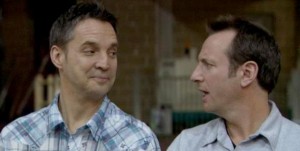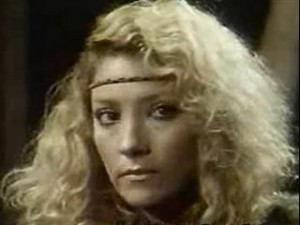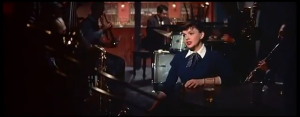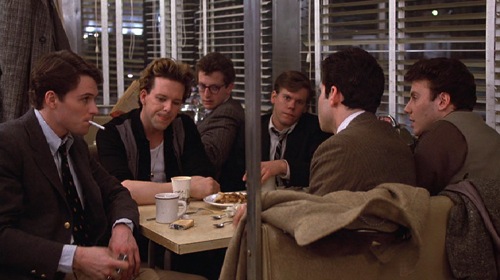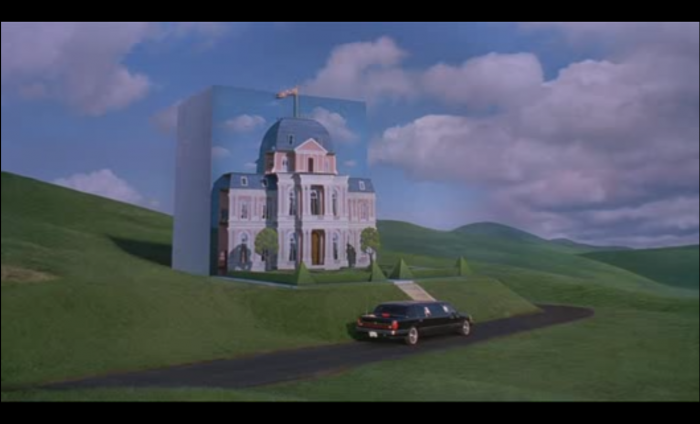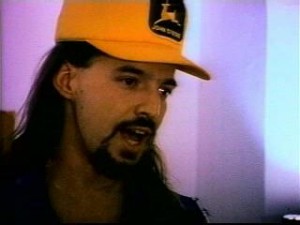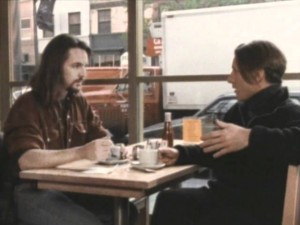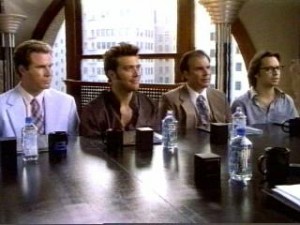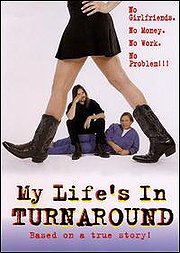From the Chicago Reader (September 2, 1994). — J.R.
** MY LIFE’S IN TURNAROUND
(Worth seeing)
Directed and written by Eric Schaeffer and Donal Lardner Ward
With Schaeffer, Ward, Lisa Gerstein, Dana Wheeler Nicholson, Debra Clein, Sheila Jaffe, John Sayles, Martha Plimpton, Phoebe Cates, and Casey Siemaszko.
As a member of the New York film festival’s selection committee, I’ve seen or sampled close to 150 films (shorts and features) this summer that haven’t yet opened in the United States, about a quarter of them American. And I’ve come to a few rough conclusions about the differences between new American movies and those recently made elsewhere, and had a few thoughts about trends in American studio and independent pictures. All of them are fairly depressing.
One major difference between foreign and American fiction features stands out: those made in other countries tend to be about how people live today, and those made here tend to be anything but. The few American movies that spring to mind as exceptions are already being regarded within the business as uncommercial — difficult, marginal works earmarked for “special” audiences.
This state of affairs is partly the result of new definitions of “universality” developed by the studios over the past several years, which generally suppose that the ideal movie viewer has the taste and sensibility of a ten-year-old boy: think of the well-received Speed, Forrest Gump, and True Lies, for instance, none of which betrays a view of the adult world any more developed than those in The Lion King and The Mask. If one compares these films with some of the top-ten money-makers of the mid-50s — a period commonly regarded today as repressed and escapist — one finds plenty of fluff (How to Marry a Millionaire, White Christmas, Cinerama Holiday, Around the World in 80 Days) along with some enduring classics (Gentlemen Prefer Blondes, Rear Window, A Star Is Born, The Searchers), but within both categories the quotient of adult fare is unmistakably higher.
This impasse may also have something to do with the highly protected and circumscribed (i.e., blinkered) lives led by big-time studio filmmakers. Most of them start out knowing something about life as it’s lived outside the industry, some of which may find its way into their early pictures — Barry Levinson’s Diner is a fair example — but after they exhaust this material they’re likely to produce something like Levinson’s Toys.
In the commercial sphere today one mainly finds some movies that are more or less serious about the past and others that purvey outright fantasies about the present, often inflected by styles and attitudes associated with the past. (True Lies comes to us courtesy of James Bond; The Mask is the progeny of The Nutty Professor; and if you want to make a misogynist movie nowadays without courting critical disfavor, one sure way is to dress it up in noir trappings.) In the independent sphere one is likelier to find fiction movies about the way Americans currently live, though most of these are concerned with certain predefined social, ethnic, demographic, regional, and generational groups and are generally marketed accordingly: gay films, ghetto films, Generation X films, and so on. To these categories one should add a new subgenre, the independent feature about trying to make an independent feature, examples of which include last year’s Emma and Elvis and In the Soup and Tom DiCillo’s forthcoming Scene Six Take One. Coming out this week is My Life’s in Turnaround, a comedy by a cabdriver and a bartender in New York about a cabdriver and a bartender in New York trying to make an independent feature.
One clear advance among many of these independent films is that their sensibilities are adolescent rather than preteen, though the characters are usually older than teenagers: Go Fish is the clearest recent example, but Reservoir Dogs, Naked in New York, Barcelona, and Spanking the Monkey also qualify, and so does My Life’s in Turnaround, both of whose lead characters are in their early 30s. Insofar as these movies are charming, it’s often because the characters behave like goofy, gawky, ineffectual teenagers, confused about their identities and their futures — often to the extent that viewers, whatever their ages, are made to feel parental and protective. (Independent features in which young adults behave like young adults rather than teenagers are a good deal scarcer, and probably seem more esoteric as a consequence; last year’s wonderful Ruby in Paradise is a case in point.)
Eric Schaeffer and Donal Lardner Ward — the coproducers, cowriters, codirectors, and costars of My Life’s in Turnaround — have indicated that the main differences between their fictional counterparts and themselves have to do with savoir faire. This isn’t surprising, because it’s impossible to imagine that the hapless characters in the movie could have financed or made any movie at all, much less this one. And the world of producers and production companies they try to navigate is just as dumbed down and distorted — a surreal, satiric version of the way the independent film scene generally operates.
Both cabdriver Schaeffer and bartender Ward, like their characters Splick Featherstone and Jason Little, have backgrounds in fringe theater, and there is an improvised quality to their filmmaking. Their direct inspiration for this movie was Nick Gomez’s underrated, ultracheap Laws of Gravity. After they decided to make a movie about their own lives, Schaeffer happened to pick up actress Phoebe Cates in his cab one day, pitched the idea of a movie to her, and got her to agree to look at a script. The same scene is reenacted with Cates in My Life’s in Turnaround (though Featherstone and Little are too bemused to even consider writing a script), and there’s a comparable real-life reenactment with Martha Plimpton in a coffee shop, complete with scatological dialogue.
Obviously more invented, or at least more caricatured, are the dysfunctional love lives of the two heroes, which provide much of the film’s adolescent flavor. Featherstone habitually importunes strangers in the street and invariably strikes out; Little compulsively courts teenyboppers in the bar where he works, sagely lecturing them about the “shared love” of the 70s, which was “free and nonjudgmental,” meanwhile fleeing hysterically from serious relationships with older women. For dramatic purposes the film also manufactures a not-very-convincing fight and extended rift between the two friends, but otherwise the filmmakers reportedly either restaged or took off from events that actually happened. Pointedly, the real story — how they raised the money to make this picture — is kept mostly offscreen; aspiring filmmakers hoping to educate themselves in this craft are likely to be disappointed.
A few of the personal details siphoned into the picture are obscure clutter: when Ward is seated at a piano at one point, the camera lingers over an adjacent newspaper photo captioned “Famous Screenwriter at Elaine’s,” which makes sense only after one learns from the press book that Ward’s father was one of the founders of the New York restaurant and that screenwriter Ring Lardner Jr. is Ward’s great-uncle. But usually the movie’s casual sense of detail gives it a whiff of quirky authenticity; the whole thing was shot in only 15 days, and part of the movie’s charm is that it looks it.
Most of the scenes are pleasantly dopey and lightweight rather than laugh-out-loud funny; the two exceptions are a couple of meetings between the heroes and potential backers, both arranged by an agent friend (Lisa Gerstein) who reluctantly succumbs to their pressure. The first meeting is with Casey Siemaszko, playing himself, who speaks in arcane trade jargon and alludes to three projects “tied up with French money,” then pulls out a three-volume script the size of a model skyscraper and gamely proposes, “Read it, get a feel for it.” When Featherstone and Little discover that the script is in Polish, Siemaszko assures them, in classic industry fashion, “It’s the story, it’s the characters — don’t worry about the words.” Even funnier is John Sayles as a philistine marginal producer who claims to have a deal with Warner Brothers.
The homemade quality of these scenes and others is what puts the movie across; it’s evident throughout that no-budget filmmaking and life as it’s lived have a certain reciprocal relationship. After all, the principal function of the many millions of dollars heaped on studio releases is to obliterate as much as possible of the world outside the movie theater; here, by hook or by crook, it keeps storming back in, invited or not.

